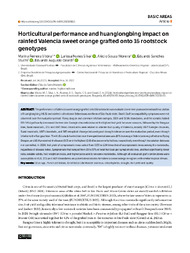Horticultural performance and huanglongbing impact on rainfed Valencia sweet orange grafted onto 16 rootstock genotypes.
Horticultural performance and huanglongbing impact on rainfed Valencia sweet orange grafted onto 16 rootstock genotypes.
Autoria: VITÓRIA, M. F.; SILVA, L. N.; MOREIRA, A. S.; STUCHI, E. S.; GIRARDI, E. A.
Resumo: ABSTRACT The performance of Valencia sweet orange grafted onto 16 rootstocks was evaluated over nine years under natural inoculation of huanglongbing (HLB) and rainfed cultivation in Bebedouro, northern of São Paulo state, Brazil. Graft incompatibility symptoms were not observed over the evaluation period. Flying dragon and common trifoliate oranges, 1600 and 1614 citrandarins, and the somatic hybrid RR+VK significantly decreased the tree size. Swingle citrumelo induced the highest fruit yield for seven seasons, followed by the Rangpur lime, Sunki mandarin, 1711 and 1697. Most citrandarins were related to a better fruit quality of Valencia, notably 1697. Swingle citrumelo, Sunki mandarin, 1697 citrandarin, and 385 tetraploid citrange induced good drought tolerance over the evaluation period, even though inferior to the Rangpur lime. The HLB cumulative incidence at the experimental area was 40% in average. Valencia trees grafted onto Flying Dragon, and 1614 presented the lowest (0.5) and the highest (2.8) disease severity indices, respectively, even though inoculation date was not controlled. In 2020, fruit yield of symptomatic trees varied from 0.55 to 1.24 times that of asymptomatic trees among the rootstocks, regardless of disease index. Symptomatic fruit ranged from 20 to 57% of total fruit load per symptomatic tree, and had significantly lower ratio, soluble solids, fruit weight and size, and higher juice acidity on some rootstocks. Although all evaluated graft combinations were susceptible to HLB, 1711 and 1697 citrandarins are potential rootstocks for Valencia sweet orange in regions with similar tropical climate.
Ano de publicação: 2024
Tipo de publicação: Artigo de periódico
Unidade: Embrapa Mandioca e Fruticultura
Palavras-chave: Candidatus Liberibacter asiaticus, Citrus, Drought, Fruit quality, Fruit yield, Fruta Cítrica, Poncirus

